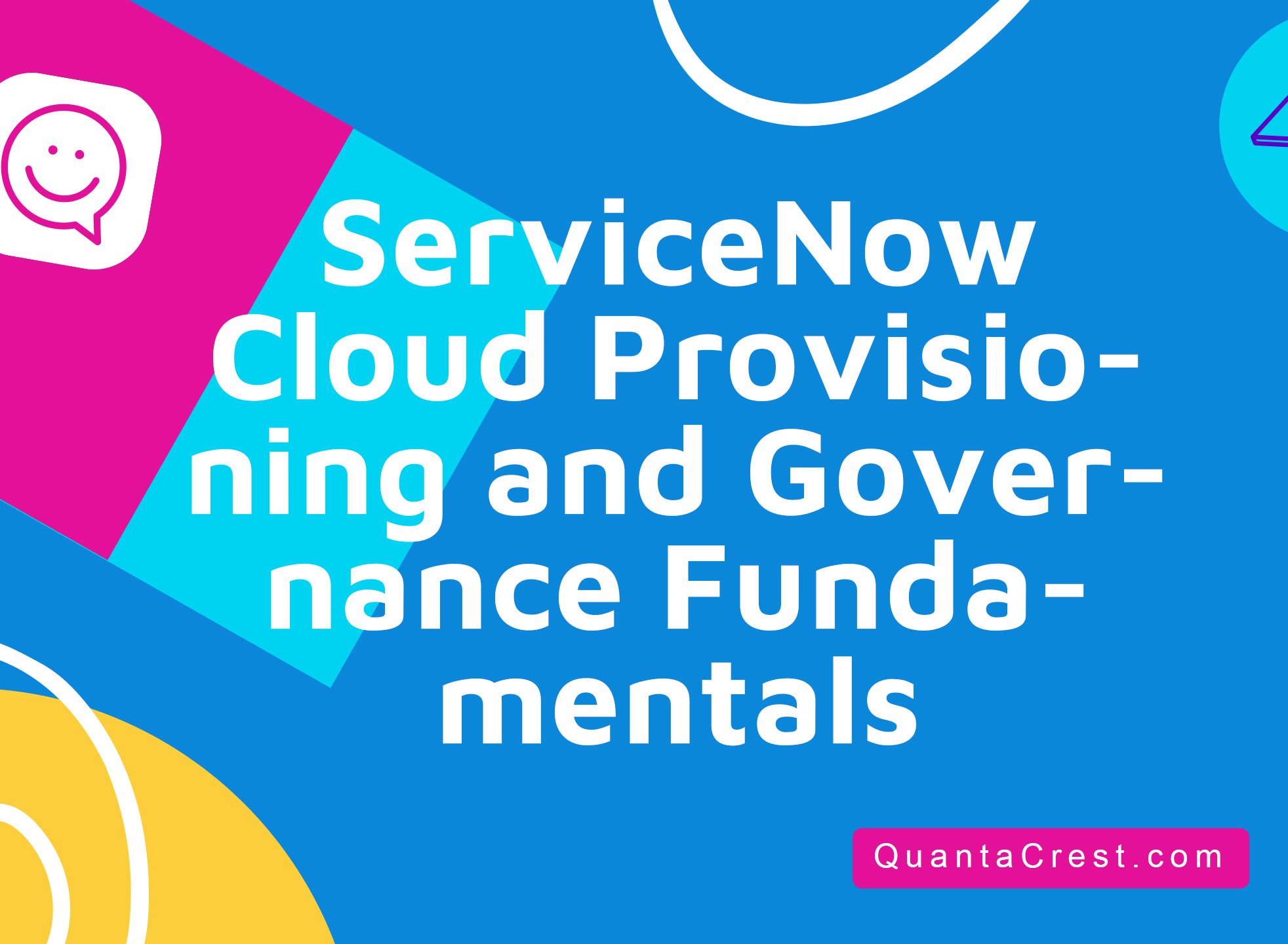ServiceNow Cloud Provisioning and Governance Fundamentals
in ServiceNow
Created by
QuantaCrest
About this course
Course Overview
Many Enterprises leverage a virtualization and multi cloud strategy that includes vendors such as AWS, Azure, Google, IBM and VMware. The numerous benefits of a multi cloud strategy are often offset by complexity, a lack of visibility and an inability to control cost. The ServiceNow Cloud Provisioning and Governance Platform helps to remove the complexity of multi cloud use, provides visibility and makes it easy for End Users to consume cloud resources. This 3-day class will teach attendees how to deploy and configure the ServiceNow Cloud Provisioning and Governance Platform to create multi cloud experience that makes it easy for end users to consume resources from AWS, Azure and VMware. The course will also show attendees how to use the Cloud Provisioning and Governance application to apply governance and policies to control the use and consumption of cloud resources.Target Audience
Anyone responsible for Cloud Provisioning and Governance in ServiceNow.Course Objectives
Upon completion of the course, students will have gained experience in how to setup a Cloud User Portal, how to deploy simple application stacks using native cloud templating technologies and Terraform. The course will also teach students how to control cloud sprawl by using Cloud Provisioning and Governance approval policies, resource profiles and capacity limits.
Course Topics
- Connecting CMP to Azure, AWS, and VMware
- Configuring Cloud Alerts
- Configuring Billing
- Creating Compute, OS, and Security Group Profiles.
- Cloud Templates. Importing AWS Cloud Formation and Azure ARM Templates
- Using Terraform configuration files to deploy VMs in Azure and VMware
- Troubleshooting
- The End User Experience
- Using Policy to manage and secure the end user experience. Approvals, dynamic templates, and access controls.
Course Content
DAY 1
Module 1: Introduction and the Cloud User Portal
- Lab 1.1: Explore Roles
Module 2: Administration and the Cloud Admin Portal
- Lab 2.1: Validate MID Server
Module 3: AWS
- Lab 3.1: Configure AWS Credential
- Lab 3.2: Configure AWS Cloud and Service Account
- Lab 3.3: Configure a Discovery Schedule
- Lab 3.4: Test Setup with a CloudFormation Template
- Lab 3.5: Configure Cloud Events for AWS
Module 4: Resource Profiles
- Lab 4.1: Configure a Compute Profile
- Lab 4.2: Configure OS Profiles
DAY 2
Module 5: Permissions and Quotas
- Lab 5.1: Configuring Identity
- Lab 5.2: Permissions
- Lab 5.3: Configuring Quotas
Module 6: Troubleshooting
Module 7: Templates and Catalog Items
- Lab 7.1: Create an AWS Specific CFT
- Lab 7.2: Version a CFT
- Lab 7.3: Customize a CFT with Metadata
Module 8: Blueprints
- Lab 8.1: Import a Blueprint
DAY 3
Module 9: Policy
- Lab 9.1: VM Naming Standard Policy
- Lab 9.2: Approval Policy
Module 10: Azure
- Lab 10.1: Configure Azure Credentials
- Lab 10.2: Configure the Azure Cloud and Service Account
- Lab 10.3: Configure an Azure Discovery Schedule
- Lab 10.4: Configure Azure Cloud Alerts
- Lab 10.5: Configure an Azure Compute Profile Mapping
- Lab 10.6: Configure an Azure OS Profile Mapping
- Lab 10.7: Create a Stack using an ARM Template
- Lab 10.8: Deploy an Azure VM with Terraform
Module 11: VMware
- Lab 11.1: Connect VMware to ServiceNow
- Lab 11.2: Create a VMware Compute Profile Mapping
- Lab 11.2: Create a VMware OS Profile Mapping
- Lab 11.3: Configure the vCenter Event Collector
- Lab 11.4: Deploy a VMware VM with Terraform
Course Prerequisites
- Completion of the ServiceNow Fundamentals course or equivalent experience
- Three to six months of experience as a ServiceNow Administrator or ServiceNow Application Designer
- Recommended knowledge of:
- Windows Server Administration
- Linux Server Administration
- Azure or AWS Cloud
- VMware
- JSON
- JavaScript
Follow on Courses
The following are recommended for further study:- SNCPGA - ServiceNow Cloud Provisioning and Governance Advanced
Comments (0)

0
0 Reviews





